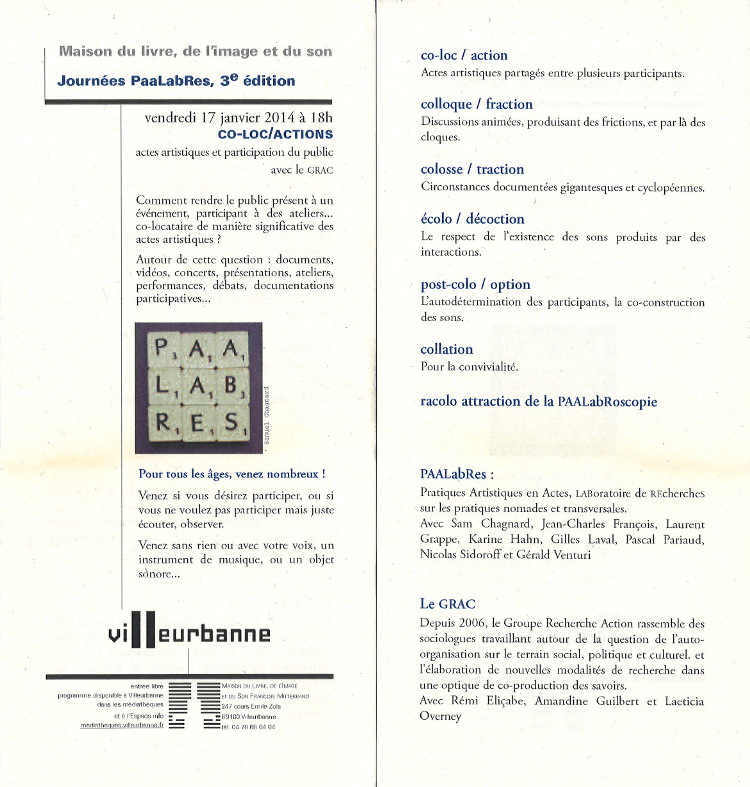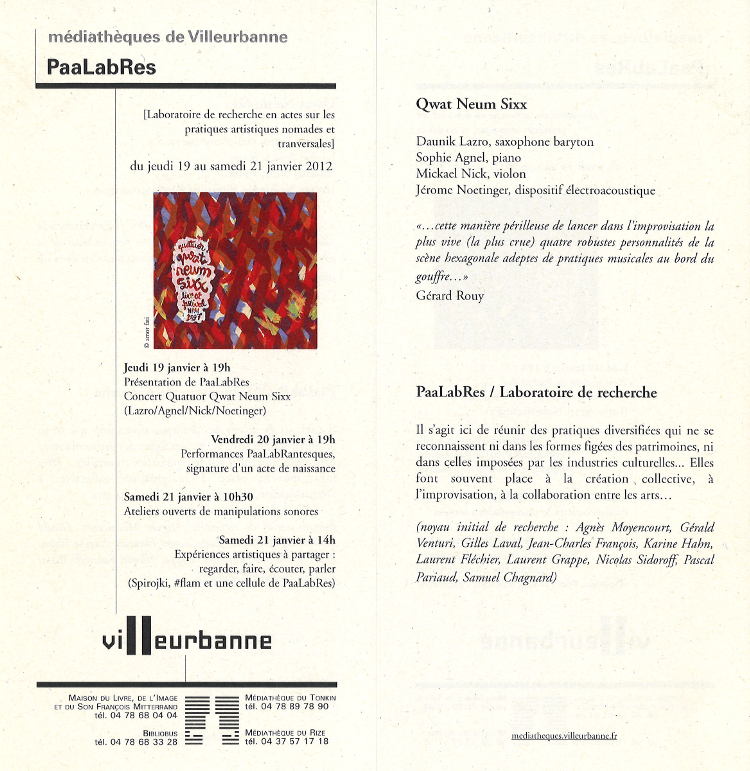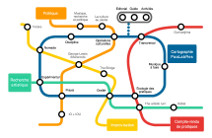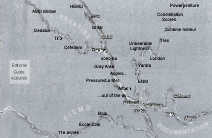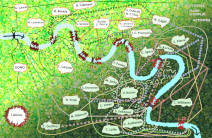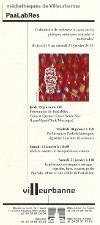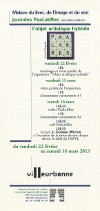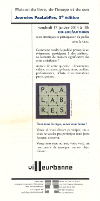Liste des contributrices et contributeurs
Édition 2017, « Partitions Graphiques »
Nous souhaitons remercier les personnes qui ont aidé de manière bénévole à la production de cette nouvelle Édition « Partitions graphiques » en tant que lecteurs, lectrices et correctrices, correcteurs : Anne Baby, Cécile Guiller, Nancy François, Monica Jordan, Pascal Pariaud, Gérald Venturi. Merci à Christian Lhopital pour sa contribution à la présentation graphique de la carte.
La production de l’Édition 2017 a été réalisée par Samuel Chagnard, Jean-Charles François et Nicolas Sidoroff.
Didier Aschour, guitariste et compositeur qui vit à Montpellier. Soliste engagé dans la musique contemporaine, il a créé de nombreuses œuvres. Il développe un répertoire original tant dans ses travaux sur les musiques microtonales que sur la musique expérimentale. En 1996, il fonde l’ensemble Dedalus consacré aux partitions à instrumentation libre et à la musique minimaliste. En 2007, il rejoint le collectif du Festival Sonorités à Montpellier. Il fait partie du comité de rédaction de la revue Revue&Corrigée.
didier.aschour.free.fr
Elaine Barkin, compositrice, essayiste et performer vivant à Los Angeles (Californie). Elle a enseigné au Queens College (1964-70), à l’Université de Michigan (1970-74), Princeton (1974) et UCLA (1974-97). Elle est membre fondatrice de la publication Open Space et a beaucoup contribué au développement de Perspectives of New Music en tant qu’éditeur et auteur de nombreux articles.
elainerb[chez]ucla.edu
Carl Bergstrœm-Nielsen, compositeur, improvisateur, musicothérapeute. Il enseigne à l’Université de Aalborg au Danemark la musique intuitive et la notation graphique. Il est membre de l’Intuitive Music Group depuis 1990. Depuis 2002, il a développé l’International Improvised Music Archive.
intuitivemusic.dk
Samuel Chagnard, musicien, membre de PaaLabRes, formateur au Cefedem Auvergne Rhône-Alpes, doctorant au Centre Max Weber, équipe « Dispositions, pouvoirs, cultures, socialisations ».
Socialisation(s) musicale(s)
Dominique Clément, compositeur, clarinettiste, membre de l’Ensemble Aleph, directeur adjoint du Cefedem Auvergne Rhône-Alpes.
clementdomi@gmail.com
Jürgen De Blonde, compositeur, artiste sonore depuis plus de 25 ans. Il vit à Gand en Belgique, où il fait partie de l’équipe artistique d’Aifoon. Il a une large ouverture vers toutes sortes de sons et en particulier pour les sons décalés. Instrumentiste multiple jouant dans un large éventail de styles, mais jamais un virtuose à la technique hardcore. Il est versatile et ludique et il aime l’expérimentation et l’improvisation.
aifoon.org
Guillaume Dussably, musicien, spécialiste de la production et des musiques électroniques. Il compose pour la danse, le théâtre, la vidéo. Par ailleurs il est musicien “live” électronique spécialiste de la synthèse sonore dans plusieurs projets musicaux. Il enseigne à l’ENM de Villeurbanne et au Cefedem AuRA.
tangram.asteroache.com
Jean-Charles François, percussionniste, compositeur, membre de PaaLabRes, du trio d’improvisation PFL Traject et de l’Ensemble Aleph.
jeancharles.francois[chez]orange.fr
Bastien Gallet, enseigne la philosophie et la théorie des arts à la Haute école des arts du Rhin. Il a été producteur à France Culture, rédacteur en chef de la revue Musica Falsa et directeur du festival Archipel. Il fut pensionnaire à l’Académie de France à Rome (Villa Médicis) et membre du DICRéAM. Il fut à l’École nationale supérieure des beaux-arts de Lyon responsable du projet de recherche La Forme des idées. Il dirige aujourd’hui les éditions MF. Son travail est philosophique et romanesque. Il est l’auteur de romans, de livrets d’opéra et de plusieurs essais sur la musique et les arts visuels.
Laurent Grappe, compositeur, musicien. Son travail sur la poésie du son enregistré l’a conduit à composer un certain nombre de pièces électroacoustiques pour lesquelles il crée systématiquement un dispositif spécifique permettant une « mise en scène » du son, que ce soit en direct ou enregistré en amont. Dans ses propositions, il fait intervenir des comédiens, musiciens, plasticiens, voire le public même.
grappelau[chez]gmail.com
Charlène Guillot, musicienne, flûtiste et pianiste, elle a obtenu le DUMI au CFMI de Lyon et poursuit ces études de Master.
charlene.guillot4225[chez]laposte.net
David Gutkin, chercheur musicologue, spécialiste des musiques américaines et européennes du XXe siècle, avec une spécialisation dans les technologies et médiations de la musique (de la notation à la télévision). Il enseigne à l’Université Columbia, New York. Ses intérêts particuliers se portent sur l’opéra et le théâtre musical, l’improvisation expérimentale et le free jazz, la composition post 1945 (sérialisme, minimalisme, spectralisme) et la musique populaire américaine des 40 dernières années.
music.columbia.edu
Claire Haranger-Segui, musicienne éclectique, enseigne à l’Académie Musique et Danse de Miribel et au Cefedem Auvergne Rhône-Alpes.
clairesegui[chez]gmail.com
Collectif Ishtar, créé en 1993. « Le Collectif Ishtar » regroupe des artistes engagés dans les pratiques artistiques expérimentales pluridisciplinaires de l’improvisation libre. Il a toujours développé des projets pluridisciplinaires, invitant des musiciens, de nombreux danseurs, poètes, vidéastes et cinéastes. Il a aussi travaillé sur la question de l’espace de représentation. Le Collectif est basé à Bourg-en-Bresse (Ain). Il est composé de Benoît Cancoin, contrebasse, Tony Di Napoli, pierres sonores / installations, Eddy Kowalski, saxophone et Xavier Saïki, guitares, objets.
collectif.ishtar.free.fr
Monica Jordan, après des études de piano et musicologie au conservatoire de Bucarest, elle obtient les prix d’analyse et d’esthétique au Conservatoire national supérieur de musique de Paris. Titulaire d’une maîtrise d’ethnomusicologie, elle se perfectionne en chant avec Rita Streich, Sena Jurinac, Cathy Berberian, et est lauréate du concours international Gaudeamus de Rotterdam. Elle a enseigné l’analyse de la musique contemporaine à l’École nationale de musique de Créteil. Membre fondatrice de l’Ensemble Aleph. Interprète des classiques du XXe siècle (Berio, Scelsi, Cage, Kurtág, Kagel, Xenakis, Aperghis, Stockhausen), elle effectue, en collaboration avec des compositeurs, des recherches dans le domaine des techniques vocales liées à l’électroacoustique et au théâtre musical.
monica.haffner[chez]gmail.com
Étienne Lamaison, clarinettiste et titulaire d’un Doctorat en Interprétation musicale de l’Université d’Évora (Portugal). Sa thèse s’intéresse à l’interprétation des partitions graphiques non procédurales, c’est-à-dire, celles pour lesquelles ni une temporalité ni un sens de lecture n’est imposée par leur auteur. Il enseigne au Pôle Supérieur de Nantes.
elamaison[chez]sapo.pt
Gilles Laval, musicien, membre de PaaLabRes, du trio d’improvisation PFL Traject, responsable du département rock à l’ENM de Villeurbanne.
gilleslaval[at]free.fr
Noémi Lefebvre, auteur d’une thèse de science politique sur l’enseignement musical et les idéologies nationales en Allemagne et en France (1994), elle s’intéresse, dans le cadre de ses recherches comme dans l’écriture, à la rencontre entre idées politiques et idées sur l’art. Elle responsable du Centre d’études sur l’enseignement et les pratiques musicales au Cefedem AuRA. Elle a publié trois romans. Elle est aussi l’auteur de deux essais sur Maurice Fleuret et Marcel Landowski.
blogs.mediapart.fr/noemi-lefebvre
Christian Lhopital, depuis plus d’une trentaine d’années, il élabore une œuvre fondée essentiellement sur la pratique du dessin, qu’il soit couché sur papier, sur toile ou déployé sur de larges surfaces murales. Il fait naître de ses compositions fluides et complexes un univers foisonnant et poétique, marquée par l’enfance et ses figures récurrentes prenant parfois la forme de projections mentales dont on ne sait si elles procèdent du rêve ou du cauchemar. Le travail de Christian Lhopital paraît animé par la conviction profonde que le dessin recèle un champ infini de possibles et qu’en choisissant de l’exprimer selon de multiples procédés techniques, celui-ci permet les visions les plus personnelles, au confluent de l’intime et d’un questionnement universel sur la condition humaine.
www.dda-ra.org/LHOPITAL
Frederico Llach, musicien de jazz et compositeur classique, originaire de Buenos Aires qui vit en Californie. Sa création musicale combine l’atmosphère intime des concerts avec l’énergie de la musique populaire. Sa palette sonore a été changée radicalement par son expérience des synthétiseurs modulaires et les technologies électroniques, ce qui a influencé ses pièces acoustiques. Il finit ses études de doctorat à l’Université de Californie Santa Barbara et il est le directeur du Now Hear Ensemble.
fredericollach.com
Lucie Marchais, est une jeune dessinatrice originaire du bassin d’Arcachon. Passionnée par le dessin et la musique, elle a trouvé en l’animation un art permettant de concilier les deux. Elle est diplômée à l’école Emile Cohl, et travaille désormais dans le domaine de l’animation 2D. Après une escale en Thaïlande où elle a travaillé en tant qu’animatrice à Cartoon Network, elle est à présent basée sur Lyon où elle continue de développer son univers graphique autour de thématiques anthropologiques inspirées par différentes civilisations.
lucie-marchais.com
Frédéric Mathevet, plasticien et compositeur. Chercheur associé à l’ACTE (UMR 8218) à Paris I (CNRS). Docteur es arts, il est co-rédacteur en chef de la revue en ligne L’Autre Musique et du laboratoire du même nom qui entremêle chercheurs et praticiens dans un acte créatif libéré et porteur. Plasticien et poéticien ouvert à tout polymorphisme, à toute mutabilité, il se définit lui-même comme un « bricoleur » enchevêtrant les supports qu’ils soient numériques, picturaux ou sonores.
mathevetfrederic.bandcamp.com
Rob Mazurek, compositeur électroacoustique, improvisateur, cornettiste, artiste multimédia. Il a d’abord émergé de la scène musicale créative du Chicago des années 1990 et est devenu un explorateur du monde sonore dans une multitude de contextes stylistiques. Mazurek est membre (entre autres) du Exploring Star Orchestra, du Chicago Underground, et du São Paulo Underground.
robmazurek.com
Julie Mehretu, artiste plasticienne originaire d’Éthiopie. Les peintures et dessins de Mehretu se réfèrent à des éléments de cartographie et d’architecture, pour accéder à une complexité calligraphique qui ressemble aux atmosphères turbulentes et aux réseaux sociaux de grande densité. Son œuvre s’inscrit dans l’histoire de l’art non objectif – du Constructivisme au Futurisme – posant les questions contemporaines sur les rapports entre les impulsions utopiques et l’abstraction. Elle travaille et vit à Berlin.
Pierre-Stéphane Meugé, saxophoniste et compositeur, il a fait ses études au Conservatoire de Strasbourg. Il est le premier professeur de saxophone aux Cours d’été de Darmstadt (1988-1994). Fondateur du Quatuor XASAX et soliste au Klangforum Wien (1994-1998), il devient le soliste de l’Ensemble 2e2m. Il enseigne le saxophone et la musique de chambre à la Haute Ecole de Musique de Lausanne (HEMU) et mène une intense activité de soliste dans de nombreux pays (Russie, Japon, U.S.A., Indonésie, Ukraine).
psmeuge[chez]wanadoo.fr
Alexander Ness vit et enseigne à San Francisco. Pour son plaisir, il produit des œuvres dans divers domaines artistiques et la musique. Ses œuvres sont présentées localement (par exemple à l’Artists’ Television Access et au Center for New Music) et à l’étranger (récemment en Italie au Composit Festival, Rieti, et en Israël au Herzliya Museum of Contemporary Art). Il aime collaborer avec des amis et des étrangers. Il a eu la chance de travailler avec un certain nombre de compositeurs : Yoni Niv, André Mestre, Caroline Mallonée, Jim Altieri et Sam Pluta. Il s’intéresse à explorer les intersections singulières entre la méditation bouddhiste, et la résolution d’énigmes et de problèmes de math.
nesssoftware.com
Yoni Niv, compositeur, artiste sonore et théoricien. Il écrit des compositions acoustiques et électroacoustiques qui intègrent un large éventail de pratiques liées à la performance, souvent en collaborant avec des artistes travaillant dans différents médias. Sa musique est jouée par des ensembles reconnus de musique contemporaine, tels que KNM Berlin, International Music Ensemble (ICE) et le quatuor JACK et ses installations sonores ont été exposées dans des musées et des galleries en Israël et à l’étranger. Yoni a un doctorat en composition et théorie de la New York University. Il enseigne actuellement la composition à la Musrara School of art, et à la Basis Art School en Israël. Il est le co-directeur de l’ensemble Musica Nova en Israël et le co-fondateur du programme d’études « sound art and experimental music » à la Musrara School of art.
yoniniv.org
Pascal Pariaud, instrumentiste, souffleur de tuyaux, chanteur et chef de chœur, improvisateur, prof à l’ENM de Villeurbanne, membre de PaaLabRes, membre de PFL-Traject, d’un duo de Poésie sonore et de divers ensembles sur instruments anciens.
pascalpariaud[ché]gmail.com
David Samas, compositeur, curateur, artiste conceptuel, créateur d’instruments et sculpteur social vivant à San Francisco. Ses peintures font partie de la collection permanente Di Rosa et sont exposées aux galeries Diego Rivera et Canessa. Il a joué dans de nombreux lieux dans la baie de San Francisco. David a été le curateur de plusieurs expositions et de festivals de musique. Il est directeur de l’association Thingmajigs (Oakland) pour le développement culturel dans la communauté. David écrit de façon régulière des partitions non conventionnelles pour le Cardew Choir, ROVA, le Gamelan Encinal et pour son propre collectif d’inventeurs Pet the Tiger.
bayimproviser.com/david-samas
Xavier Saïki, guitariste, improvisateur, basé dans l’Ain. Il travaille le son, la matière brute et les phénomènes acoustiques ; le moment présent, la fragilité, la densité empilée, et le presque rien. Il utilise principalement la guitare préparée, qu’elle soit électrique ou acoustique, ainsi que d’autres dispositifs électroacoustiques de sa fabrication. Il est membre du Collectif Ishtar (voir ci-dessus) et de « la Tribu hérisson ».
collectif.ishtar.free.fr
Matthieu Saladin, artiste et musicien, vit et travaille à Paris. Sa pratique s’inscrit dans une approche conceptuelle de l’art, réfléchissant, à travers un usage récurrent du son, sur la production des espaces, l’histoire des formes et des processus de création, ainsi que sur les rapports entre art et société du point de vue économique et politique. Elle prend aussi bien la forme d’installations sonores et de performances que de publications (livres, disques), de vidéos et de créations de logiciels. Il est maître de conférences en arts sonores à l’université Paris 8. Sa recherche théorique porte principalement sur l’art sonore et les musiques expérimentales.
matthieusaladin.org
Alain Savouret, compositeur de musiques électroacoustiques, instrumentales, ainsi que d’œuvres pédagogiques. Il s’intéresse à la matière sonore, à la virtuosité au clavier, à l’économie du matériau compositionnel ainsi qu’à l’improvisation. Il développe, à partir de 1987, le concept de « maîtrise d’œuvre », opération musicale menée sur une longue période avec les acteurs de la vie locale et leur patrimoine sonore pour une unique représentation. De 1992 à 2007, il enseigne au Conservatoire de Paris et crée la classe d’improvisation générative, classe expérimentale et interdisciplinaire. Il développe ainsi une pensée et une pratique musicales s’appuyant sur l’« auralité » (du latin auris : oreille), dans une perspective qu’il nomme « phonoculturelle ».
cdmc.asso.fr/biographies/savouret-alain
Nicolas Sidoroff, musicien->militant<-chercheur, entre autre membre de PaaLabRes, formateur au Cefedem Auvergne Rhône-Alpes, webm@ster de ce site, etc…
John Tilbury, pianiste vivant en Angleterre. Il est considéré comme l’interprète majeur de la musique de Morton Feldman. Membre du groupe d’improvisation AMM depuis 1980. Pendant les années 1960 il a été associé avec le compositeur Cornelius Cardew et un membre du Scratch Orchestra. Auteur d’un livre très important sur Cardew mêlant informations biographiques avec des analyses des compositions et des idées philosophiques.
Gérald Venturi, musicien, membre de PaaLabRes, enseignant à l’ENM de Villeurbanne.
gerald.venturi[chez]gmail.com
Léa Vernet, musicienne, étudie le hautbois en vue de l’obtention d’un DEM.
lea-vrnt[at]hotmail.fr
Christopher Williams, compositeur, improvisateur, contrebassiste. Il est un voyageur sur le continuum du corps-esprit dans le domaine de la musique. Originaire de Californie, il vit actuellement à Berlin. Sa recherche porte sur l’improvisation, la notation et le feedback entre la pensée, la perception et l’action dans la musique expérimentale.
christopherisnow.com
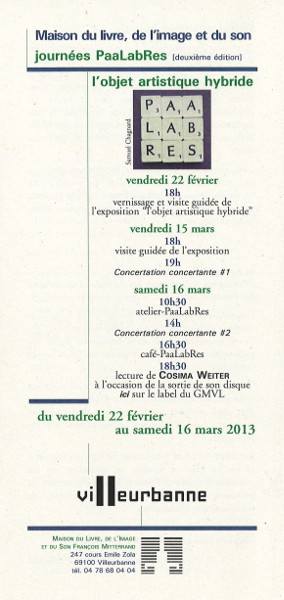
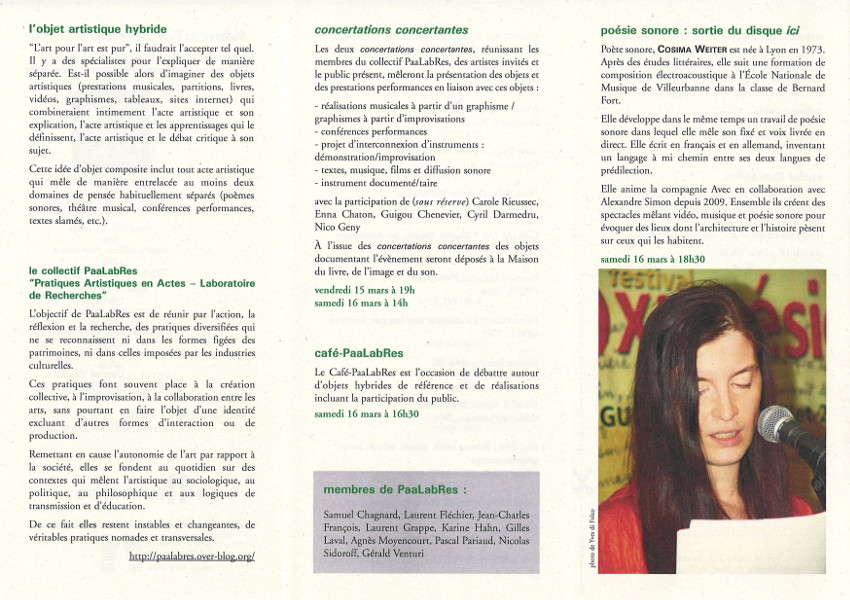
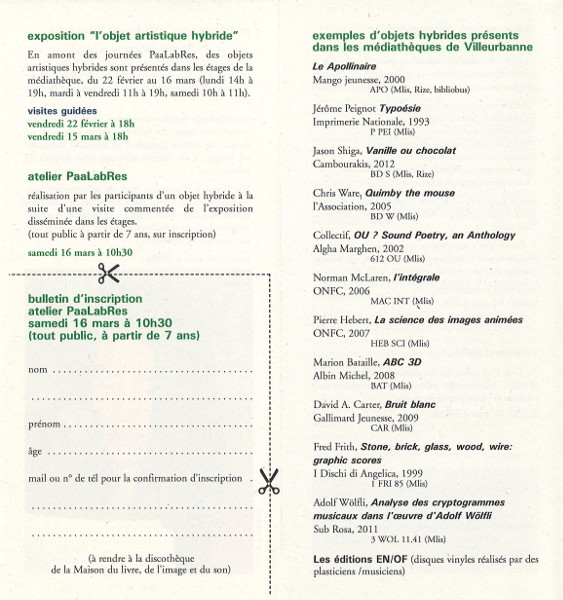
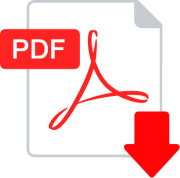 (FR)
(FR)